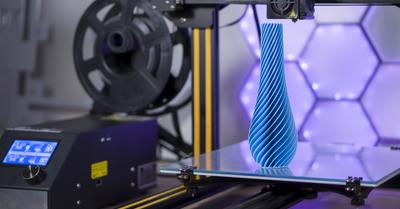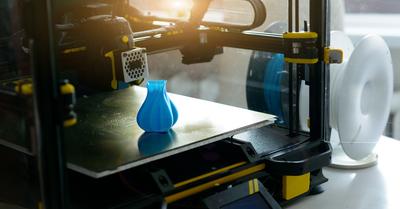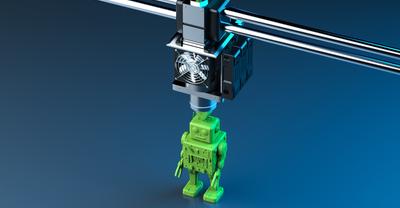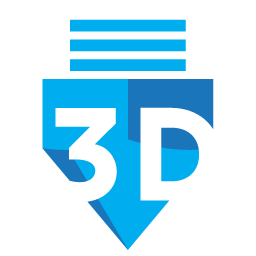Impact of 3D Printing
If you've come here to learn about the impact of 3D printing on traditional manufacturing jobs, it's safe to assume you're already familiar with 3D printing and how it works. If not, you can read our article on ‘What Is 3D Printing?’.
It is a fact that 3D printing has changed the way products are manufactured. The amount of design and manufacturing freedom it provides is unprecedented, and thus learning it becomes extremely important going forward.
The transition to 3D printing is inevitable as technology matures. Today's major challenge for manufacturers is that 3D printing cannot mass produce in shorter lead times. If this problem is solved, the transition will be quick, and the impact on manufacturing and the workforce will be enormous.
We examine the impact of 3D printing on manufacturing businesses and jobs, while also observing the growth of core 3D printing jobs.
Impact On Manufacturing Businesses
According to Shapeways' 2021 survey report, 34 percent of companies surveyed use 3D printing as their primary production method, while 41 percent use the technology for production but not as their primary method.
Furthermore, more than 55 percent of those polled are fully mature in 3D printing adoption, with the remaining 33 percent in the process of achieving maturity.
According to 55% of the stakeholders polled, 3D printing is the future and will replace existing processes.
All of these survey results indicate that 3D printing technology is certain to gain a strong foothold in the coming decade, and no individual or organization can afford to ignore it.
The primary advantages of 3D printing for manufacturing businesses include lower operational costs, increased revenues, better products, satisfied customers, and so on.
The key impact of 3D printing on Businesses:
- Rapid Prototyping: Small batches of parts can be created in a matter of hours using 3D printing. This has spawned the art of rapid prototyping, which allows businesses to test a new concept or idea in days rather than weeks.traditional manufacturing processes
- Customization: The world is moving towards consumerism and personalization and traditional manufacturing cannot keep pace with this growing change. 3D printing offers unprecedented advantages in customization and will only grow in importance as the demand for personalized products grows.
- Part Consolidation: When it comes to part consolidation, GE has led the way in demonstrating the power of 3D printing. The ‘Poster Boy’ of 3D printing - the CFM LEAP engine fuel nozzle, was consolidated from 20 different parts earlier into a single 3D printed part. This has a significant impact on assembly time and cost. This advantage is termed as Part Consolidation. Conventionally, where 20 different parts would have been assembled step by step at various stages of assembly, 3D printing eliminated the entire assembly stage. It may not be possible to eliminate assembly in all cases but it can significantly reduce the assembly time in most cases.
- Lower Manufacturing Costs: Early-stage manufacturing processes that are transitioned from traditional methods to 3D printing result in lower manufacturing costs. In most cases, using additive manufacturing to create prototypes, jigs, tooling, and fixtures is much more cost-effective. However, because processes such as injection molding are still more cost-effective at scale, shifting all manufacturing to 3D printing is not yet feasible.
Impact of 3D Printing on Manufacturing Jobs
We saw how 3D printing outperforms traditional manufacturing processes in a variety of ways. According to the trends, 3D printing is the future, and it will be adopted by an increasing number of organizations for their manufacturing needs.
This adoption will also have a significant impact on workforce needs and future workforce skills. We look at some of the manufacturing jobs that are being threatened by the rise of 3D printing.
Manufacturing Jobs in Danger
Assembly line workers
As previously stated, assembly time is reduced or eliminated, which means that the workforce in the assembly section is drastically reduced, rendering them obsolete in a world where 3D printing is widely used.
Warehouse workers
Manufacturers uniquely benefit from 3D printing. The ability to produce parts on-demand. This capability is now being researched and applied extensively in spare parts management. This also implies that businesses intend to reduce their carrying inventory of spare parts, replacement parts, and contingency parts significantly. This will not only reduce inventory investments but will also reduce warehouse space, implying fewer warehouse personnel.
Furthermore, with the advent of virtual warehouses, businesses no longer need to carry physical inventories. As and when parts are required, virtual files can be downloaded and 3D printed on-demand.
Traditional Machine Operators
As the use of 3D printing technology expands, the need for traditional machines will diminish. This means that the requirement of traditional machine operators, such as lathe machine operators, will diminish. This talent pool will see a year-on-year decrease in job opportunities, remaining at a stable level but far below the current requirement.
3D Printing Jobs in Demand
While many job positions may become obsolete, this does not imply that all job opportunities will be reduced. It is self-evident that as new technology emerges, so do new job opportunities and roles. 3D printing has the potential to improve workforces in a variety of ways. We look at some new and existing jobs in the manufacturing sector that will become more prominent in the coming years.
Design Engineers
The foundation of 3D printing designs. 3D printing cannot proceed without a CAD design, so the job will become increasingly important as the technology spreads. While design engineers are already in demand in the manufacturing industry, those understanding the principles of designing for additive manufacturing (DfAM) remains limited. This job will become more important and in high demand over the next decade.
Research & Development
When a technology is new and in its early stages, there is a high demand for people with research and development backgrounds. This role is already in high demand, and it will continue to rise over the next decade. For critical areas such as printer research, laser research, material research and qualification for critical applications, software development, and so on, experienced personnel is required.
New Product Development
3D printing technology is still in its early stages and has a low market penetration. As small and large manufacturing organizations begin to adopt the technology, they will require the assistance of new product development engineers or teams to explore new products that can be manufactured using 3D printing technology to gain a competitive advantage over their competitors.
3D Printer Operators
Operating a 3D printer is another new skill that is in high demand. While FDM and SLA 3D printers are relatively simple to use, industrial systems such as DMLS/SLM/DED/Binder Jetting, and so on, are quite complicated for beginners. Companies seek candidates who have the necessary skills to operate and maintain these machines. The demand for 3D printer operators is increasing all the time.
Post-Processing Engineer
Almost all 3D printed parts necessitate post-processing. Because of the complex shapes that 3D printers can create, post-processing becomes quite complex and critical. This job becomes even more critical when dealing with metal parts.
Because mechanical properties and stresses differ between machines, post-processing engineers must also determine the best method for post-processing the various 3D printed parts. Metal parts made using two different 3D printing technologies (DMLS and EBM or Binder Jetting, for example) will have different properties and internal stresses, so the post-processing technique used must be unique to the part and the machine. This is a difficult task, and engineers must be knowledgeable about the technology to make sound decisions.
Although a few companies have developed automated post-processing systems, they must still be operated and run efficiently, so post-processing engineers will be in high demand in the coming decade.
Sales & Marketing
This is the lifeblood of any organization, without which no products are sold and no revenue is generated. This is the most in-demand role right now. Almost every company has openings in their sales and marketing departments. However, this is also the role with the highest attrition rate worldwide. Because the technology is new, futuristic, and expensive, most people find the responsibility daunting. It's a difficult job, but it's also one of the most rewarding.
Applications Engineer
In the 3D printing industry, applications engineers are those engineers who are concerned with closely working with the client and developing applications for them that are relevant to the machine, material, or software that they are selling. Often, an applications engineer will create a mutually beneficial project to demonstrate the capabilities of the manufacturer's product.
Occasionally, the applications engineer is also in charge of training and relaying technical information to customer service/field representatives, assisting in the creation of technical publications, and utilizing their expanding knowledge in relatively new fields.
Depending on the company's product offering, these are mostly mechanical engineers, materials engineers, and software engineers. They frequently work at the plants of their customers and are constantly on the move.
Trainers
Because 3D printing technology is still in its early stages, the role of trainers is expanding rapidly. Some argue that they are laying the groundwork today for the future of 3D printing, which will be visible tomorrow. Most printer and software manufacturers are looking for trainers who can provide on-site and online training to their customers or potential customers to get them up to speed on the company's latest offering. The training also helps customers get a better return on their investment, and new customers see it as a big help when making a large capital investment in machines, materials, or software.
Trainers are also in high demand in schools, colleges, and universities to teach and train young children and future engineers who will work in the 3D printing industry.
Lawyers & Legal Professionals
It is a well-known fact that 3D printing is fraught with legal ramifications. Even today, many 3D printing companies are suing one another over legal issues. Experts believe that as technology advances and becomes more democratized, more legal issues involving copyright, trademark, and patent violations will arise.
It is not creating a new job market, but existing lawyers should keep an eye on what happens in the 3D printing industry to seize a good opportunity to carve a niche for themselves in this industry.









